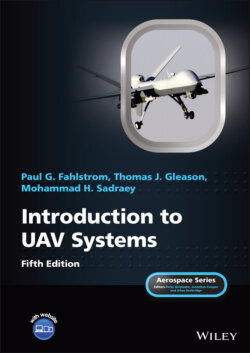Читать книгу Introduction to UAV Systems - Mohammad H. Sadraey - Страница 73
3.6 Drag Polar
ОглавлениеAnother important concept concerning the three‐dimensional air vehicle is what is known as the aircraft drag “polar,” a term introduced by Eiffel many years ago, which is a curve of CL plotted against CD. A typical airplane drag polar curve is illustrated in Figure 3.13.
The drag polar will later be shown to be parabolic in shape and define the minimum drag (or zero‐lift drag), CDo, or drag that is not attributable to the generation of lift. A line drawn from the origin and tangent to the polar gives the minimum lift‐to‐drag ratio that can be obtained. It will also be shown later that the reciprocal of this ratio is the tangent of the power‐off glide angle of an air vehicle. The drag created by lift or induced drag is also indicated on the drag polar.
The drag coefficient is the sum of two terms: (1) zero‐lift drag coefficient (CDo) and (2) induced drag coefficient (CDi). The first part is mainly a function of friction between air and the aircraft body (i.e., skin friction), but the second term is a function of local air pressure, which is represented by the lift coefficient. Pressure drag is mainly produced by flow separation. The sum of the pressure drag and skin friction (friction drag – primarily due to laminar flow) on a wing is called profile drag. This drag exists solely because of the viscosity of the fluid and the boundary layer phenomena.
The drag coefficient is a function of several parameters, particularly UAV configuration. A mathematical expression for the variation of the drag coefficient as a function of the lift coefficient is
(3.5)
This equation is sometimes referred to as aircraft “drag polar.” The variable K is referred to as the induced drag correction factor. It is obtained from
(3.6)
where e is the Oswald span efficiency factor and AR is the wing aspect ratio. The aspect ratio is defined as the ratio of wingspan over wing mean aerodynamic chord (b/C). It is also equal to wingspan squared divided by wing area or b2/S. The variable AR is further discussed in this chapter.
Figure 3.13 Airplane drag polar
